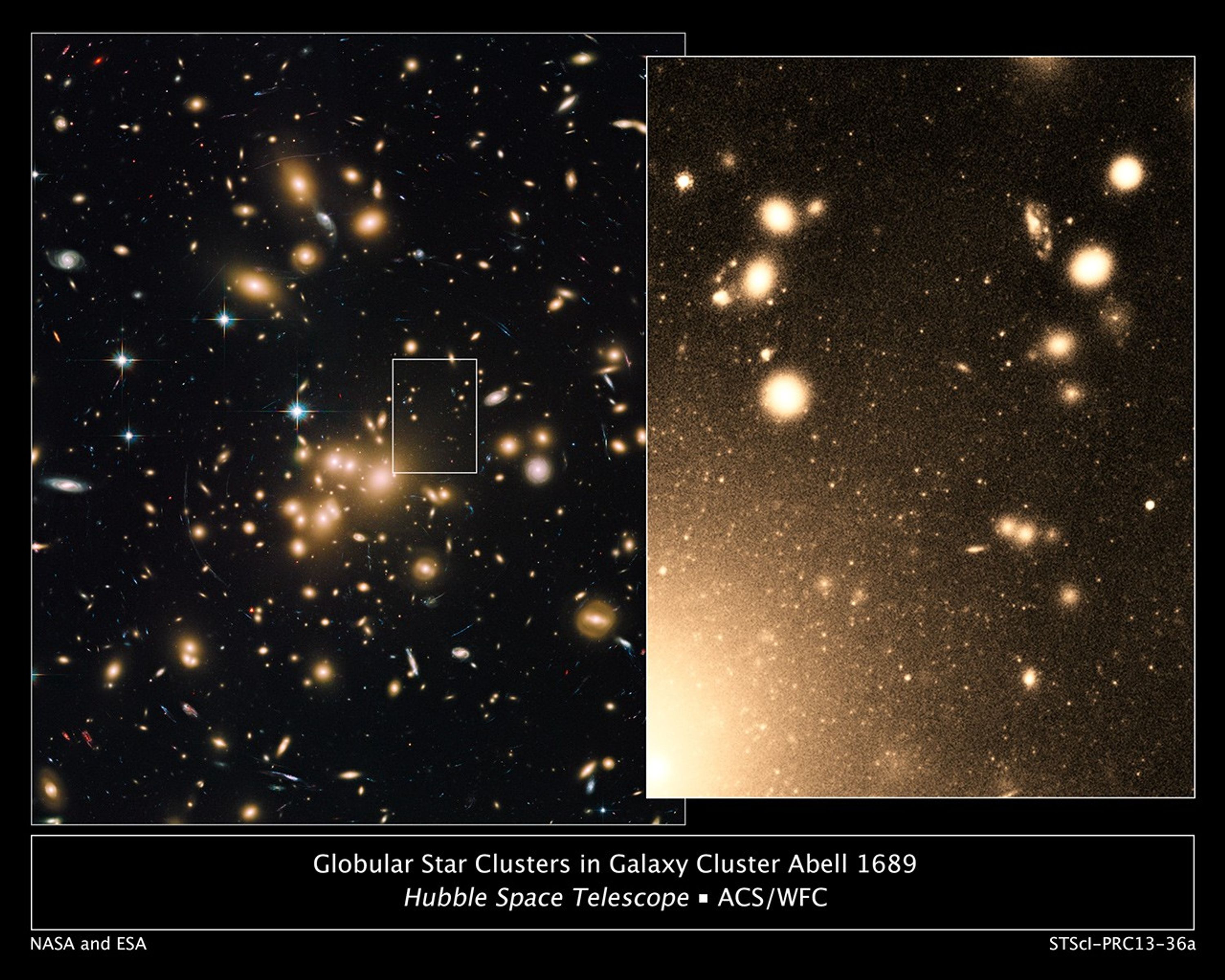1 min read
Globular Star Clusters in Galaxy Cluster Abell 1689

Hubble Finds Galaxy Cluster Abell 1689 Full of Giant Star Clusters
Peering deep into the heart of the massive galaxy cluster Abell 1689, NASA's Hubble Space Telescope has nabbed more than 160,000 globular clusters, the largest population ever seen.
The image at left, taken by Hubble's Advanced Camera for Surveys, shows the numerous galaxies that make up Abell 1689. The box near the center outlines one of the regions sampled by Hubble, containing a rich collection of globular clusters.
The monochromatic view at right, taken at visible wavelengths, zooms into the region packed with globular clusters. They appear as thousands of tiny white dots, which look like a blizzard of snowflakes. The larger white blobs are entire galaxies of stars.
Globular clusters, dense collections of hundreds of thousands of stars, are the homesteaders of galaxies, containing some of the oldest surviving stars in the universe. Almost 95 percent of globular cluster formation occurred within the first 1 billion or 2 billion years after our universe was born in the big bang 13.7 billion years ago.
Hubble's Advanced Camera for Surveys snapped these images from June 12 to 21, 2002, and between May 29 and July 8, 2010.
Members of the science team are John Blakeslee; Karla Alamo-Martinez and Rosa Gonzalez-Lopezlira, Center for Radio Astronomy and Astrophysics of the National Autonomous University of Mexico, in Morelia; Myungkook James Jee, University of California, Davis; Patrick Cote and Laura Ferrarese, DAO/NRC Herzberg Astrophysics; Andres Jordan, Pontifical Catholic University of Chile, in Santiago; Gerhardt Meurer, International Centre of Radio Astronomy Research, University of Western Australia, in Perth; Eric Peng, Kavli Institute for Astronomy and Astrophysics, Peking University; and Michael West, Maria Mitchell Observatory, in Nantucket, Mass.
About the Object
- R.A. PositionR.A. PositionRight ascension – analogous to longitude – is one component of an object's position.13h 11m 34.19s
- Dec. PositionDec. PositionDeclination – analogous to latitude – is one component of an object's position.-1° 21' 56.0"
- ConstellationConstellationOne of 88 recognized regions of the celestial sphere in which the object appears.Virgo
- DistanceDistanceThe physical distance from Earth to the astronomical object. Distances within our solar system are usually measured in Astronomical Units (AU). Distances between stars are usually measured in light-years. Interstellar distances can also be measured in parsecs.2.25 billion light-years (690 megaparsecs)
About the Data
- Data DescriptionData DescriptionProposal: A description of the observations, their scientific justification, and the links to the data available in the science archive.
Science Team: The astronomers who planned the observations and analyzed the data. "PI" refers to the Principal Investigator.ACS/WFC data of Abell 1689 were obtained as part of HST proposal 11710 : J. Blakeslee (NRC Herzberg Astrophysics Program, Victoria, B.C.)
Proposal co-Is include science team members listed below plus R. Bouwens (Leiden University), R. Barber DeGraaff (Washington State University), D. Magee (University of California, Santa Cruz), L. Bradley (STScI), and A. Zirm (University of Copenhagen).
Authors on the science paper include: J. Blakeslee (NRC Herzberg Astrophysics Program, Victoria, B.C.), K. Alamo-Martinez and R. Gonzalez-Lopezlira (National Autonomous University of Mexico) M.J. Jee (University of California, Davis), P. Cote and L. Ferrarese (DAO/NRC Herzberg Astrophysics), A. Jordan (Pontifical Catholic University of Chile), G. Meurer (University of Western Australia, Perth), E. Peng (Kavli Institute for Astronomy and Astrophysics, Peking University), and M. West (Maria Mitchell Observatory).
- InstrumentInstrumentThe science instrument used to produce the data.HST>ACS/WFC
- Exposure DatesExposure DatesThe date(s) that the telescope made its observations and the total exposure time.June 12 - 21, 2002, May 29, 2010, and July 8, 2010
- FiltersFiltersThe camera filters that were used in the science observations.F475W (g), F625W (r), F775W (i), F814W (I), and F850LP (z)
- Object NameObject NameA name or catalog number that astronomers use to identify an astronomical object.Abell 1689
- Object DescriptionObject DescriptionThe type of astronomical object.Galaxy Cluster and Globular Star Clusters
- Release DateSeptember 12, 2013
- Science ReleaseHubble Uncovers Largest Known Population of Star Clusters
- Credit

Note: The release image is a composite of the F814W (I) data from proposal 11710, taken May 29 - July 8, 2010, and F475W (g), F625W (r), F775W (i), and F850LP (z) data from proposal 9289, PI: H. Ford (JHU), taken June 12 - 21, 2002. This image is a composite of separate exposures acquired by the ACS instrument on the Hubble Space Telescope (HST). Several filters were used to sample broad wavelength ranges. The color results from assigning different hues (colors) to each monochromatic (grayscale) image associated with an individual filter. In this case, the assigned colors are: Galaxy Cluster (left): Blue: F475W (g)Green: F625W (r)Red: F775W (i) + F850LP (z) Globular Star Clusters (right):Blue: F475W (g)Green: F625W (r)Red: F775W (i) + F814W (I) + F850LP (z)

Related Images & Videos

Hubble Wide-Field Image of Galaxy Cluster and Gravitational Lens Abell 1689
This new image from Hubble of the massive galaxy cluster Abell 1689 shows the phenomenon of gravitational lensing with unprecedented clarity. This cluster acts like a cosmic lens, magnifying the light from objects lying behind it and making it possible for astronomers to explore...
Share
Details
Claire Andreoli
NASA’s Goddard Space Flight Center
Greenbelt, Maryland
claire.andreoli@nasa.gov































